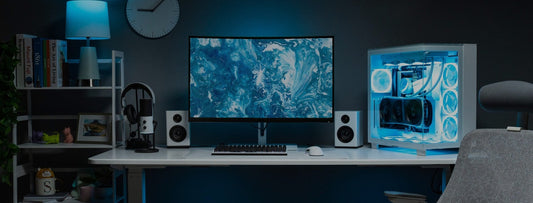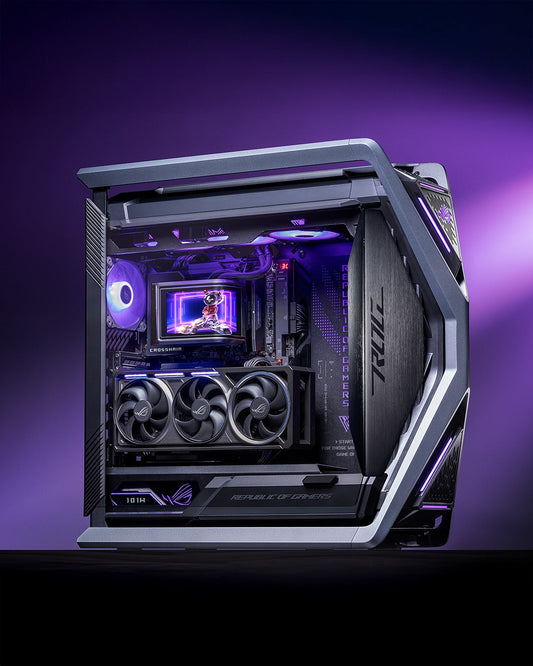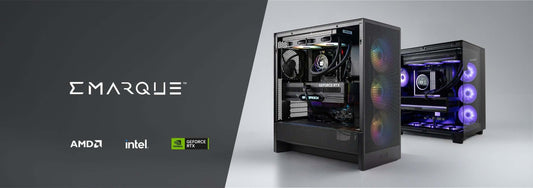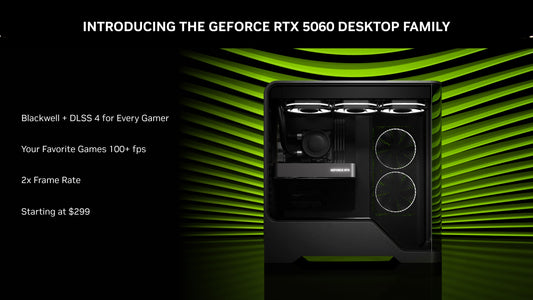
Guides for Video Editing hardware in 2024
In this article, we will explore the essential components for video editing, the recommended hardware components for 2024, and the future trends in video editing hardware technology.
From high-performance processors to advanced graphics cards and cutting-edge storage solutions, we will discuss everything you need to know to stay ahead in the world of video editing.
Let's dive in and discover what the future holds for video editing hardware components!
Key Takeaways:
1. By 2024, video editing hardware will require high-performance processors, dedicated graphics cards, large amounts of RAM, fast & reliable storage, and high-resolution monitors.
2. Future trends in video editing hardware will see advancements in processors, development of specialized graphics cards, increase in RAM capacity, new storage technologies, and the introduction of high-resolution monitors.
3. In order to keep up with the demands of video editing in 2024, it will be essential to invest in top-of-the-line hardware components that can handle the high-resolution footage and intensive editing processes.
What Are the Essential Components for Video Editing?
Video editing requires a combination of essential components for optimal performance. These components include the central processing unit (CPU), random access memory (RAM), graphics processing unit (GPU), storage options such as SSD or HDD, and other hardware components.
Each essential component plays a crucial role in ensuring smooth editing processes. The CPU acts as the brain of the system, handling complex calculations and processing tasks efficiently. RAM provides temporary storage for active editing projects, allowing for quick access to files and data. The GPU accelerates rendering and playback, enhancing the overall editing experience.
Regarding Mac and PC systems, Macs are known for their optimized performance in video editing due to their integrated hardware and software ecosystem. On the other hand, PCs offer more customization options, allowing users to select specific hardware components tailored to video editing requirements.
Processor (CPU)
The processor, also known as the CPU, plays a crucial role in video editing tasks such as decoding, manipulating footage, and rendering effects. It acts as the brain of the computer, processing video files efficiently based on the technology landscape and software compatibility.
Regarding video editing, the efficiency of the CPU can greatly impact the overall performance and speed of the editing process. A powerful CPU can handle complex editing software and tasks with ease, ensuring smoother workflow and quicker rendering times. CPUs from Intel and AMD are popular choices among video editors, with benchmarks such as clock speed, core count, and cache size dictating their processing capabilities. These benchmarks influence how quickly video effects are applied, how smoothly footage is played back, and how fast the final rendered output is produced.
Graphics Card (GPU)
The graphics card, or GPU, is essential for video editing tasks as it accelerates rendering, enhances processing power, and supports advanced effects. It plays a key role in optimizing the video editing workflow based on the technology landscape and software requirements.
Modern GPUs are designed to handle complex mathematical calculations required for rendering high-definition videos swiftly. Video editors rely on GPUs not only for rendering but also for real-time previews, allowing them to make instant adjustments and see the effects in real-time. The efficiency of a GPU significantly reduces the time needed for processing large video files, enabling editors to work more efficiently on their projects.
Choosing the right GPU can vastly improve the overall performance and productivity in video editing.
Random Access Memory (RAM)
Random Access Memory (RAM) is crucial for video editing applications as it enables efficient caching of data, faster access to files, and smoother playback. The amount of RAM in a system significantly impacts the editing experience based on the technology landscape and software requirements.
When working on large video projects, having ample RAM is essential to ensure that the editing software can seamlessly handle the high-resolution footage, effects, and transitions without experiencing lags or crashes. In such cases, a minimum of 16GB to 32GB of RAM is recommended to support the processing demands of modern editing programs like Adobe Premiere Pro, Final Cut Pro, or DaVinci Resolve.
The speed of the RAM also plays a critical role in editing efficiency. Faster RAM modules, such as those with higher frequencies or lower latency timings, can improve the overall responsiveness of the editing software, reduce render times, and enhance multitasking capabilities. Investing in high-speed RAM can lead to a more fluid editing workflow, especially when working with complex sequences or applying intensive effects.
Storage (SSD or HDD)
Storage options, including Solid State Drives (SSD) and Hard Disk Drives (HDD), are critical for video editing projects due to the large file sizes and formats involved. Choosing the right storage solution impacts the speed of reading footage, caching performance, and rendering efficiency.
SSDs are known for their blazing fast read and write speeds, making them perfect for handling high-resolution video files with ease. On the other hand, HDDs provide larger storage capacities at a more affordable price point, allowing editors to store a vast amount of footage without breaking the bank.
Regarding reliability, SSDs have the upper hand due to their lack of moving parts, making them less prone to failure compared to HDDs. This reliability factor is crucial in preventing data loss and ensuring the seamless progress of video editing projects.
In terms of workflows, the choice between SSDs and HDDs can significantly impact editing efficiency. SSDs excel in tasks that require quick access to data, such as scrubbing through timelines or applying real-time effects, while HDDs might cause delays due to slower data retrieval speeds.
Monitor
A high-resolution monitor with accurate color reproduction is essential for video editing tasks to ensure precise color grading, visual accuracy, and overall editing quality. The monitor serves as the visual interface for editing software, impacting the user experience and final output.
High resolution allows the editor to work with intricate details, ensuring that the final video retains its quality even at higher resolutions. Moreover, color accuracy is crucial for achieving consistency across different devices and platforms, essential for professional video projects. The screen size plays an important role, providing ample workspace for multitasking and arranging editing panels effectively, enhancing productivity. With a quality monitor, editors can fine-tune color tones, contrast, and brightness with precision, making adjustments that truly bring the visuals to life.
What Are the Recommended Hardware Components for Video Editing in 2024?
In 2024, video editing demands specific hardware components to meet the evolving performance requirements and software advancements. These recommended components include a high-performance processor, dedicated graphics card, large RAM capacity, fast and reliable storage solutions, and high-resolution monitors.
One of the key elements for efficient video editing is the CPU, which plays a vital role in rendering, encoding, and processing video files swiftly. Advancements in CPU technology, such as multi-core processors with higher clock speeds and improved efficiency, are critical for seamless editing experiences.
Similarly, having a powerful GPU is essential for accelerating tasks like real-time effects rendering, video playback, and enhancing overall editing performance.
A substantial RAM capacity aids in smooth multitasking, enabling editors to work on multiple high-resolution videos simultaneously without encountering lag or slowdowns. This is particularly crucial as editing software becomes more feature-rich, demanding more memory resources to operate efficiently.
Fast and reliable storage solutions like SSDs or NVMe drives are imperative for quick access to large video files, reducing loading times, and enhancing overall workflow efficiency. In addition, high-resolution monitors are essential for precise color grading and detailed video editing, ensuring accurate visualization of the final output.
High-performance Processor
A high-performance processor is essential for video editing in 2024 to handle complex tasks efficiently, improve workflow speed, and support enhanced editing features. Evaluating CPU benchmarks, software compatibility, and technology advancements is crucial when selecting the right processor for video editing needs.
When considering a high-performance processor for video editing, one must take into account not only the raw power of the CPU but also factors like multi-threading capabilities and cache size, which can significantly impact rendering times and overall editing performance.
Choosing the right CPU with a sufficient number of cores and a high clock speed ensures smoother playback, faster rendering, and seamless application of effects, culminating in a more efficient and productive editing process.
As editing software continues to advance and demand more resources, having a future-proof processor can safeguard against potential bottlenecks and ensure compatibility with upcoming editing tools and features.
Dedicated Graphics Card
A dedicated graphics card is recommended for video editing in 2024 to accelerate rendering, support noise reduction algorithms, and enhance visual effects processing. The GPU plays a vital role in optimizing editing workflows, reducing rendering times, and improving overall editing efficiency.
A dedicated graphics card ensures seamless playback of high-resolution footage and smooth real-time previews, allowing video editors to make precise adjustments instantly. The integration of GPU-accelerated effects enables faster processing of complex visual effects, resulting in a more polished final product.
Large Amount of RAM
Having a large amount of RAM is essential for video editing in 2024 to handle memory-intensive tasks, multitasking operations, and complex editing projects. The RAM capacity impacts the editing experience, software performance, and overall system stability based on the technology landscape and software requirements.
With the increasing demands of high-resolution footage, advanced effects, and intricate timelines in video editing, the need for ample RAM cannot be overstated. Insufficient RAM can result in sluggish performance, constant buffering, and crashes during editing sessions. Optimizing RAM not only enhances the speed and efficiency of editing tasks but also facilitates smooth playback and rendering processes.
Fast and Reliable Storage
Fast and reliable storage solutions, such as SSDs, HDDs, or NVMe SSDs, are recommended for video editing in 2024 to improve data access speeds, reduce latency, and enhance workflow efficiency. Choosing the right storage technology impacts file handling, caching performance, and overall editing responsiveness.
SSDs, known for their lightning-fast data access speeds and low latency, are ideal for handling large video files seamlessly, ensuring smooth playback and quick loading times during editing sessions. On the other hand, HDDs offer greater storage capacities at a more budget-friendly cost, making them suitable for storing vast libraries of raw footage and project archives.
NVMe SSDs combine the best of both worlds, providing blazing-fast read and write speeds along with high storage capacities, making them the go-to choice for professional videographers and editors looking to achieve maximum performance in their editing setups. The advancements in storage technology play a crucial role in streamlining editing workflows, enabling quick retrieval of data, efficient project management, and enhanced collaboration among team members.
High-resolution Monitor
A high-resolution monitor with accurate color reproduction is recommended for video editing in 2024 to ensure precise visual editing, color grading, and detailed image rendering. The monitor quality influences the user experience, editing precision, and final output quality based on the technology landscape and software requirements.
Regarding color accuracy, a high-quality monitor ensures that the colors you see on your screen are true to life. This is crucial in video editing to make accurate color adjustments and ensure consistency across different devices.
The screen resolution plays a vital role in displaying intricate details and sharp images, allowing editors to work on fine edits without compromising quality.
For optimal visual fidelity, monitors with a wide color gamut and high dynamic range (HDR) support are preferred. These features enrich the editing process by providing a broader range of colors and better contrast.
What Are the Future Trends in Video Editing Hardware Components?
The future trends in video editing hardware components point towards advancements in CPU performance, GPU technology, RAM capacity, storage innovations, and high-resolution monitor integration. These trends are driven by the evolving technology landscape, unique editing requirements, and the need for efficient video processing.
One of the key areas of focus is on enhancing the CPU performance to handle complex video editing tasks swiftly and efficiently. As software developers continue to push the limits with more resource-intensive applications, the demand for faster processors is on the rise.
The advancements in GPU capabilities are transforming the video editing experience. GPUs are becoming crucial for accelerating rendering processes, enabling real-time effects, and supporting high-quality visual effects.
Alongside processing power, developments in storage technologies are pivotal. From faster SSDs to larger storage capacities, these innovations cater to the ever-increasing file sizes produced in modern video editing workflows.
Advancements in Processor Technology
Advancements in processor technology are reshaping video editing workflows by offering higher processing speeds, improved multitasking capabilities, and enhanced efficiency. The competition between Intel and AMD processors drives innovation in CPU performance, software compatibility, and hardware optimization for video editing tasks.
These advancements are crucial for meeting the demands of modern video editing, where high-resolution footage, complex effects, and demanding rendering processes require robust hardware solutions. Video editors and content creators rely on cutting-edge processors to handle intensive editing tasks seamlessly, resulting in quicker project completion and enhanced productivity.
Development of Graphics Card for Video Editing
The development of graphics cards specifically tailored for video editing purposes is driving improvements in rendering speeds, real-time effects processing, and workflow optimizations. Both AMD and NVIDIA are actively enhancing GPU technologies to meet the increasing demands of video editing software and content creation.
In recent years, AMD and NVIDIA have made significant strides in optimizing GPU acceleration for video editing applications, pushing the boundaries of what is possible in terms of performance and efficiency. One of the key advantages of these advancements is the seamless integration with popular video editing software, enabling professionals to work with large files and complex effects in real time.
The competition between AMD and NVIDIA continues to spur innovation in graphics card development, resulting in faster rendering times, smoother playback, and improved overall user experience for video editors.
Increase in RAM Capacity
The increasing demand for RAM capacity in video editing systems reflects the need for faster data access, improved multitasking capabilities, and enhanced project handling. Hardware upgradeability options cater to the evolving RAM requirements of video editors, allowing for seamless scalability and performance enhancements.
With higher RAM capacities, video editors can run multiple applications simultaneously without experiencing lags or slowdowns. This boosts productivity by reducing waiting times and streamlining workflow processes. Larger RAM sizes enable smoother video playback and rendering, leading to quicker editing iterations and faster completion of projects.
The ability to expand RAM through hardware upgrades ensures that video editing setups can adapt to the increasing demands of resource-intensive editing software. This future scalability not only prolongs the lifespan of the workstation but also enhances its overall performance, providing a cost-effective solution for professionals seeking long-term efficiency.
Emergence of New Storage Technologies
The emergence of new storage technologies such as SSDs, HDDs, and NVMe SSDs is revolutionizing data access speeds, file management efficiency, and content delivery in video editing workflows. These innovations cater to the evolving storage needs of video editors, offering faster processing times and enhanced project handling capabilities.
SSDs provide lightning-fast read and write speeds, reducing rendering times and allowing editors to work seamlessly with high-resolution footage. On the other hand, HDDs excel in storing large amounts of data at a lower cost, making them ideal for archiving and long-term storage.
NVMe SSDs take performance to the next level with their ultra-fast speeds, significantly improving the responsiveness of editing software and enabling real-time multi-stream video editing without any lag. These advancements enable editors to handle complex projects more efficiently and meet tight deadlines with ease.
Introduction of High-resolution Monitors
The introduction of high-resolution monitors with precise color accuracy is reshaping the visual editing experience, color grading precision, and image rendering quality in video editing environments. These monitors enhance the user interface, editing accuracy, and final output quality based on the technology landscape and editing software demands.
Utilizing high-resolution monitors has significantly improved the color accuracy for content creators and video editors. The ability to see subtle color variations and gradients with greater clarity allows for more precise adjustments during the color grading process. The increased screen resolution ensures that edits are done with pixel-perfect detail, resulting in a more visually pleasing end product. The enhanced visual fidelity offered by these monitors elevates the overall editing quality, making the content appear sharper, more vibrant, and true to the creator's vision.
Outtro
Understanding the essential components, recommended hardware upgrades, and future trends in video editing hardware is crucial for optimizing editing workflows, enhancing performance, and delivering high-quality content. By staying informed about the evolving technology landscape and hardware advancements, video editors can effectively meet the unique requirements of modern editing tasks.
Regarding video editing, a seamless workflow relies heavily on the right hardware setup. From the central processing unit (CPU) and graphics processing unit (GPU) to the amount of RAM and storage capacity, each component plays a vital role in the editing process.
Fast loading times, smooth playback, and efficient rendering are all directly impacted by the hardware choices made. It's important to keep abreast of the latest advancements in hardware technology to ensure that your editing system remains optimized and capable of handling the demands of high-resolution video editing tasks.
Frequently Asked Questions
What video editing hardware components will be popular in 2024?
In 2024, it is expected that the most popular video editing hardware components will be the latest processors with high processing speeds, powerful graphics cards, and ample RAM.
Why are these specific components important for video editing?
These components are crucial for video editing as they determine the speed and efficiency of the editing process. A fast processor, high-quality graphics card, and sufficient RAM will ensure smooth and seamless editing.
What are the benefits of using a high-speed processor for video editing?
A high-speed processor, such as the latest INTEL I9 14900K / RYZEN 9 7950X, will greatly reduce rendering and exporting times, allowing for a more efficient workflow. It also enables editing of high-resolution and 4K videos without experiencing lags or crashes.
How does a powerful graphics card enhance video editing?
A powerful graphics card, like the latest NVIDIA RTX 4070 TI onwards, can handle complex graphics and effects in real-time, allowing for a more accurate and precise editing experience. It also supports hardware acceleration, which can significantly speed up the editing process.
What role does RAM play in video editing?
RAM, or Random Access Memory, is essential for storing and accessing data quickly. In video editing, having ample RAM, such as 5,9&9,9, allows for smooth playback, multitasking, and handling of large files, resulting in a more efficient editing process.
Are there any other important hardware components for video editing in 2024?
In addition to a fast processor, powerful graphics card, and ample RAM, other important hardware components for video editing in 2024 may include high-speed solid-state drives for storing and accessing files, and high-quality monitors for accurate color grading and viewing.




